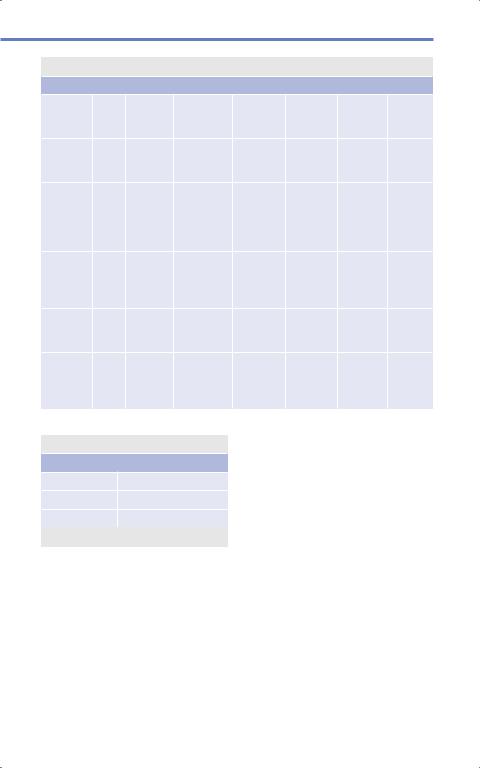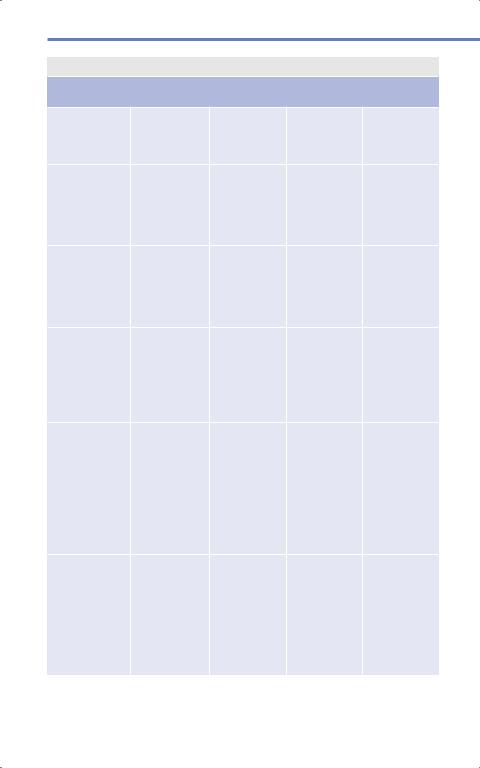
Книги по МРТ КТ на английском языке / Neurosurgery Fundamentals Agarval 1 ed 2019
.pdf
7.7 Top Hits
[6]Matthay MA, Ware LB, Zimmerman GA. The acute respiratory distress syndrome. J Clin Invest. 2012; 122(8):2731–2740
[7]Fan E, Needham DM, Stewart TE. Ventilatory management of acute lung injury and acute respiratory distress syndrome. JAMA. 2005; 294(22):2889–2896
[8]Jones TH, Morawetz RB, Crowell RM, et al. Thresholds of focal cerebral ischemia in awake monkeys. J Neurosurg. 1981; 54(6):773–782
[9]Bratton SL, Chestnut RM, Ghajar J, et al; Brain Trauma Foundation. American Association of Neurological Surgeons. Congress of Neurological Surgeons. Joint Section on Neurotrauma and Critical Care, AANS/CNS. Guidelines for the management of
severe traumatic brain injury. IX. Cerebral perfusion thresholds. J Neurotrauma. 2008; 25(3):276–278.
[10]Muizelaar JP, Marmarou A, Ward JD, et al. Adverse effects of prolonged hyperventilation in patients with severe head injury: a randomized clinical trial. J Neurosurg. 1991; 75(5):731–739
[11]Lozier AP, Sciacca RR, Romagnoli MF, Connolly ES, Jr. Ventriculostomy-related infections: a critical review of the literature. Neurosurgery. 2002; 51(1):170–181, discussion 181–182
[12]Gardner PA, Engh J, Atteberry D, Moossy JJ. Hemorrhage rates after external ventricular drain placement. J Neurosurg. 2009; 110(5):1021–1025
129
Agarwal, Neurosurgery Fundamentals (ISBN 978-1-62623-822-0), copyright © 2019 Thieme Medical Publishers. All rights reserved. Usage subject to terms and conditions of license.

8 Traumatic Brain Injury
Christine Mau, Shelly Timmons
8.1 Introduction
The Centers for Disease Control and Prevention reported that in 2013, there were at least 2.8 million emergency department visits, hospitalization, or deaths related to traumatic brain injury (TBI).1 To put this in perspective, every hour, there are an average of 204 TBI-related emergency department visits, 33 TBI-related hospitalizations; and 6 TBI-related deaths.1 Overall, TBIs contribute to 30% of all injury-related deaths.1 The range of TBI spans from mild to life-threatening and the subsequent treatment ranges from observation and medical optimization to emergent surgical intervention. Understanding TBI is critical to effectively evaluate and treat these patients.
8.2 Classification of Head Injury
8.2.1 Examination to Assess Head Injury
The Glasgow Coma Scale (GCS) serves as an initial way to assess the severity of head injury ( Table 8.1). It is composed of three components: motor (6 points), verbal
(5 points), and eye response (4 points) for a minimum score of 3 and maximum score of 15. There is a separate way to assess pediatric patients using the GCS score dependent on age ( Table 8.2; see section 14.4, chapter 14). Based on the GCS, the severity of TBI can be estimated ( Table 8.3).
The common phrase “less than 8, then intubate” speaks more to the inability for the patient to protect his/her airway.
In fact, 56—60% of patients with GCS score less than or equal to 8 have one or more other organ systems injured.2 Furthermore, 4–5% have associated spine fractures. GCS can be affected by factors other than neurological injury including pharmacologics, respiratory compromise, and metabolic abnormalities. Re-evaluation once underlying issues are addressed is essential for accurate prediction of prognosis.
8.2.2 Recommendations for Imaging
In patients with minor head injury, the decision to obtain CT imaging can be difficult
Table 8.1 Adult Glasgow Coma Scale
Response |
1 point |
2 points |
3 points |
4 points |
5 points |
6 points |
Eye |
No |
Open to pain |
Open to |
Open spon- |
|
|
|
response |
|
voice |
taneously |
|
|
Verbal |
No |
Incomprensi- |
Incoherent |
Disoriented |
Appro- |
|
|
response |
ble sounds |
words |
or confused |
priate |
|
|
|
|
|
|
responses |
|
Motor |
No |
Extensor |
Flexor |
Withdraws |
Localizes |
Follows |
|
response |
(decerebrate) |
(decorticate) |
from pain |
to pain |
com- |
|
|
posturing |
posturing |
|
|
mands |
130
Agarwal, Neurosurgery Fundamentals (ISBN 978-1-62623-822-0), copyright © 2019 Thieme Medical Publishers. All rights reserved. Usage subject to terms and conditions of license.

8.2 Classification of Head Injury
Table 8.2 Pediatric Glasgow Coma Scale
Response |
Age |
1 point |
2 points |
3 points |
4 points |
5 points |
6 points |
Eye |
< 1 |
No |
Open to |
Open to |
Open |
|
|
|
year |
response |
pain |
shouting |
spontane- |
|
|
|
|
|
|
|
ously |
|
|
|
> 1 |
No |
Open to |
Open to |
Open |
|
|
|
year |
response |
pain |
com- |
spontane- |
|
|
|
|
|
|
mand |
ously |
|
|
Verbal |
< 2 |
No |
Grunts, |
Persistent |
Cries and |
Smiles |
|
|
years |
response |
agitated, |
inappro- |
consola- |
or coos |
|
|
|
|
restless |
priate |
ble |
appropri- |
|
|
|
|
|
crying or |
|
ately |
|
|
|
|
|
screaming |
|
|
|
|
2–5 |
No |
Grunts |
Persistent |
Inappro- |
Appro- |
|
|
years |
response |
|
crying |
priate |
priate |
|
|
|
|
|
and |
words |
word |
|
|
|
|
|
screaming |
|
phrases |
|
|
> 5 |
No |
Incompre- |
Inappro- |
Disori- |
Oriented |
|
|
years |
response |
hensible |
priate |
ented or |
|
|
|
|
|
sounds |
words |
confused |
|
|
Motor |
|
No |
Extensor |
Flexor |
With- |
Localizes |
Sponta- |
|
|
response |
(decer- |
(decor- |
drawal |
to pain |
neous |
|
|
|
ebrate) |
ticate) |
|
|
|
|
|
|
posturing |
posturing |
|
|
|
Table 8.3 Traumatic brain injury grading
Category |
Criteria |
Mild |
GCS 13–15 |
Moderate |
GCS 9–12 |
Severe |
GCS 3–8 |
Abbreviations: GCS, Glasgow Coma Scale.
compared to ordering CT imaging on a patient with clear neurological deficit. There are two major published recommendations to aid in decision making: the Canadian Head CT rule and the New Orleans criteria.
Canadian CT Head Rule
•Applies to patients with GCS 13–15 with witnessed loss of consciousness (LOC), amnesia, or disorientation.
•High risk of need for intervention:
◦GCS scores less than 15 at 2 hours after initial injury.
◦Suspected open or depressed skull fracture.
◦Any sign of basilar skull fracture (raccoon sign, otorrhea, rhinorrhea, Battle’s sign, hemotympanum etc).
◦More than one episode of emesis.
◦Age 65 years or older.
131
Agarwal, Neurosurgery Fundamentals (ISBN 978-1-62623-822-0), copyright © 2019 Thieme Medical Publishers. All rights reserved. Usage subject to terms and conditions of license.

Traumatic Brain Injury
•Medium risk for brain injury on CT:
◦Amnesia before injury for more than 30 minutes.
◦Dangerous mechanism including pedestrian struck, ejection from vehicle, fall from height over 3 feet, or fall down more than five stairs.
New Orleans Criteria
CT is recommended for patients with minor head injury (GCS 15) with any one of the following findings:
1.Headache.
2.Vomiting.
3.Age more than 60 years.
4.Drug or alcohol intoxication.
5.Persistent anterograde amnesia.
6.Visible trauma above the clavicle.
7.Seizure.
mortality increases with the presence of an intracranial lesion, edema causing compression of the cisterns, midline shift (MLS) more than 5 mm, and volume of the lesion more than 25 mL. Contrasted scans are often not indicated in most trauma situations unless there is suspicion for significant brain edema (visible on non- contrasted scan) secondary to suspected neoplasm or suspected altered sensorium from infectious epidural collection.
X-rays
Skull X-rays may be helpful in certain situations such as penetrating injuries. However, X-ray has low sensitivity for detecting intracranial abnormalities (roughly 25%).3 If a CT cannot be obtained, then X-rays can be used to identify pneumocephalus, skull fractures, pineal shift, and air-fluid levels.
8.2.3 Imaging to Modalities
Computed Tomography
Non-contrast CT scans of the brain can also be used to predict mortality using the Marshall Grade ( Table 8.4). Predicted
Magnetic Resonance Imaging
MRI is usually not used for acute head injuries given its lower availability on an acute basis, contraindication in critical patients who may not be able to tolerate lying
Table 8.4 Marshall Grade to predict mortality2
Category |
Cisterns |
Midline shift |
Intracerebral |
Mortality |
|
|
|
hemorrhage |
|
Diffuse injury I |
No visible |
No visible |
No visible |
9.6% |
|
pathology |
pathology |
pathology |
|
Diffuse injury II |
No pathology |
< 5 mm |
Lesion densities |
13.5% |
|
|
|
present |
|
Diffuse injury |
Compressed or |
< 5 mm |
Lesion densities |
34% |
III (swelling) |
absent |
|
< 25 mL |
|
Diffuse injury |
|
> 5 mm |
Lesion densities |
56.2% |
IV (midline |
|
|
> 25 mL |
|
shift) |
|
|
|
|
Evacuated mass |
|
|
Evacuated |
38.8% |
lesion |
|
|
|
|
Nonevacuated |
|
|
|
52.8% |
132
Agarwal, Neurosurgery Fundamentals (ISBN 978-1-62623-822-0), copyright © 2019 Thieme Medical Publishers. All rights reserved. Usage subject to terms and conditions of license.

8.2 Classification of Head Injury
flat or undergoing a longer scan, and unchanged sensitivity in detecting surgical lesions.4 MRI scans do have utility after the patient is stabilized in order to detect evidence of diffuse axonal injury (DAI, although clinical correlation is key in making this diagnosis), hypoxic injury, or punctate hemorrhages not seen on CT.
8.2.4 Brain Injury
Brain injury secondary to trauma occurs from an initial mechanical impact to the brain, sometimes called primary injury or impact damage. However, secondary injury also occurs due to alterations in a variety of cerebral physiological process, including metabolic crisis and ischemia, release of inflammatory cytokines and cytotoxins, membrane breakdown, excitotoxicity, and neurotransmission derangements.5,6 Ischemia is thought to be the most important factor leading to secondary damage. The brain is dependent on cerebral blood flow and reduction in oxygen leads to tissue damage in a physiologically predictable process. Normal, healthy brain that is able to maintain autoregulation can tolerate a cortical flow reduction to 20 mL/100 g/min. However, below 20 mL/100g/min, loss of consciousness and coma ensue.7,8,9,10,11 When this flow reduces below 18 mL/100 g/ min, energy dependent ion pumps are unable to maintain ionic gradients across the neuronal cell wall and stops functioning. This can lead to anaerobic metabolism and begins to generate lactic acid. At 10 mL/100 g/min, the cell membrane loses stability and there is a massive influx of calcium leading to irreversible damage. On pathology, there is karyorrhexis, or loss of nuclear definition, along with vacuolation of perineuronal astrocytic processes and swelling of the mitochondria, Golgi and intracellular cytoplasmic vesicles. When flow is 15–18 mL/100g/min for more than 30 minutes, selective neuronal loss may occur.12,13
Hippocampal neurons in the cornu ammonis (CA1) and CA3 layers, cerebellar granular cells, and larger cortical neurons are most susceptible to selective neuronal loss.
When flow is 10 mL/100 g/min or less for more than 60–90 minutes, infarction occurs. This dependence on cerebral blood flow for tissue integrity makes it less surprising that a single episode of hypotension with systolic blood pressure (SBP) less than 90 leads to a 150% increase in mortality for TBI patients.14
8.2.5 Hemorrhage Types
There are various types of hemorrhages depending on etiology, mechanism, and sometimes age. They vary in both appearance and location, which can provide insight into the type of hemorrhage and subsequently, the management of the hemorrhage ( Table 8.5).
Epidural Hemorrhages
Epidural hemorrhages (EDHs) are classically caused by rupture of the middle meningeal artery with an overlying fracture of the temporoparietal bone. However, this is actually only the case in approximately one-third of adults and one-fifth of children.15 EDHs can also be due to bleeding from the middle meningeal vein or dural sinus. EDHs are more common in young adult males aged 20–30 years. Additionally, skull fractures have been found in 95% of patients with EDH. The classic presentation is a brief loss of consciousness after the traumatic event, followed by a lucid interval, then rapid deterioration over several hours. Almost half of patients will present with a classic “lucid interval” and 27% will present neurologically intact.16,17
133
Agarwal, Neurosurgery Fundamentals (ISBN 978-1-62623-822-0), copyright © 2019 Thieme Medical Publishers. All rights reserved. Usage subject to terms and conditions of license.

Traumatic Brain Injury
Table 8.5 Types of hemorrhages
Type of |
Appearance |
Location |
Etiology |
Associations |
|
hemorrhage |
|
|
|
|
|
Epidural |
Lens or biconvex |
Does not cross |
Arterial bleed- |
Skull fracture |
|
hemorrhage |
|
suture lines |
ing, often the |
often overlies |
|
|
|
because of dur- |
middle menin- |
EDH because |
|
|
|
al attachment |
geal artery |
high impact |
|
Subdural |
Crescent |
Does not cross |
Venous |
Elderly patients |
|
hemorrhage |
shaped |
midline or |
bleeding, often |
have atrophy of |
|
|
|
tentorium |
due to bridging |
the brain lead- |
|
|
|
|
|
veins |
ing to increased |
|
|
|
|
|
susceptibility of |
|
|
|
|
|
bridging veins |
Subarachnoid |
Hyperdensity |
Convexity, |
Arterial |
If basilar |
|
hemorrhage |
along sulci or in |
Sylvian |
|
(starfish |
|
|
cisterns |
fissure; Inter- |
|
appearance), |
|
|
|
hemi-spheric, |
|
a ruptured |
|
|
|
cisternal |
|
aneurysm must |
|
|
|
|
|
|
be ruled out |
Intraparenchy- |
Circular or |
1. |
Basal |
Mechanical |
Severe impact, |
mal hemorrhage |
ovoid |
|
ganglia |
tearing of |
poor nutritional |
|
|
2. |
Lobar |
vessel, injury to |
status |
|
|
3. |
Cerebellar |
vessel leading |
|
|
|
|
|
to permeability |
|
|
|
|
|
and subsequent |
|
|
|
|
|
hemorrhage |
|
Contusion |
Hyperdense |
May be in any |
“Bruising” from |
“Contrecoup” |
|
|
blood; May |
location; Lobar |
acceleration/ |
injuries may |
|
|
be stippled |
common, |
deceleration, |
occur opposite |
|
|
or multiple; |
especially |
direct force |
to the site of |
|
|
May be mixed |
frontal and |
trajectories, |
impact |
|
|
density (both |
temporal lobes |
shear and rota- |
|
|
|
hyperdense |
|
|
tional forces |
|
|
blood and |
|
|
|
|
|
hypotenuse |
|
|
|
|
|
areas) |
|
|
|
|
Intraventricular |
Blood within |
Lateral, 3rd, |
In trauma, |
Can be |
|
hemorrhage |
ventricle |
and/or 4th |
often sec- |
isolated or an |
|
|
|
ventricle |
ondary from |
extension of |
|
|
|
|
|
extension from |
parenchymal or |
|
|
|
|
parenchymal or |
subarachnoid |
|
|
|
|
subarachnoid |
hemorrhage; |
|
|
|
|
|
Isolated more |
|
|
|
|
|
common in |
|
|
|
|
|
elderly patients |
134
Agarwal, Neurosurgery Fundamentals (ISBN 978-1-62623-822-0), copyright © 2019 Thieme Medical Publishers. All rights reserved. Usage subject to terms and conditions of license.

8.2 Classification of Head Injury
In adults, over 90% of EDHs occur secondary to traffic accidents, falls, and assaults. In pediatric patients, a 10% drop in hematocrit should elevate suspicion for an EDH. In pediatrics, falls account for approximately half of EDHs, while traffic accidents account for another one-third.15 Symptoms include obtundation, contralateral hemiparesis (unless Kernohan’s notch phenomenon occurs), and ipsilateral pupil dilatation (up to 44%).17,18 EDH is present in up to 4% of TBI patients, and almost 10% will present in a coma.19,20,21 The single most important prognostic factor is the GCS score at time of presentation. If GCS is 6–8, mortality is 9% whereas with GCS 3–5, mortality increases to 36%.20 Patients with no pupillary findings have a poor outcome in 30% of cases, one fixed pupil have a poor outcome in 35% of cases, and bilaterally fixed pupils have a poor outcome in 50%.22 Other poor prognostic factors are associated traumatic subarachnoid hemorrhage (tSAH), greater than 50 mL in volume, effacement of basal cisterns, and MLS more than 1 cm.22,23
If an EDH is diagnosed and treated within a few hours, mortality is estimated to be between 5 and 12%.24 More specifically, for patients that require operative evacuation, one study found that all patients with evacuation completed after 70 minutes from the onset of pupillary dilation died.25 Death is often secondary to uncal herniation causing injury to the midbrain leading to respiratory arrest. Management ranges from observing closely to emergent surgery.
Surgical Indications
1.Signs of local mass effect (symptomatic EDH).
2.Acute asymptomatic EDH more than 30 cm3, thickness more than 15 mm, or more than 5 mm midline shift on initial CT regardless of GCS.18,23,26,27,28
3.Signs of herniation23,25,29
a)Increased drowsiness, pupillary changes, hemiparesis.
4.Cardiorespiratory abnormalities.
5.Anisocoria and GCS less than 9.
Subdural Hemorrhages
Subdural hemorrhages (SDHs) are the most common traumatic intracranial lesions and occur in up to 29% of TBI patients.30 Younger patients most commonly presents after a motor vehicle accident and older patients most commonly present after a fall. Patients commonly present obtunded and up to half present with pupillary abnormalities.22,31,32,33 They can arise from injury or tearing of bridging veins in the subdural space, or bleeding from parenchymal injuries . SDHs are often associated with damage to the actual underlying brain parenchyma; therefore, although evacuation may be lifesaving, removal does not ensure a good outcome. Regardless of GCS score at presentation, mortality is between 40 and 60% whereas mortality for patients who present in a coma is 57–68%.30
There have been a multitude of studies looking at morbidity and mortality based on the thickness of the SDH, degree of midline shift, presenting GCS score, and age.34,35,36,37 Not surprisingly, larger-sized SDHs, greater degrees of associated MLS, lower presentation GCS scores, and higher ages at presentation are all associated with increased mortality and poorer outcome.34,35,36,37 As with epidural hematomas, earlier evacuation in operative patients is associated width better outcome. Evacuation within 2–4 hours of clinical decline is associated with improved morbidity and mortality.17,29,38
Kernohan’s notch phenomenon is when the brainstem shifts away from the mass and may cause compression of the opposite cerebral peduncle on the tentorial notch.39 This can cause a false localizing sign and lead to ipsilateral hemiparesis.
135
Agarwal, Neurosurgery Fundamentals (ISBN 978-1-62623-822-0), copyright © 2019 Thieme Medical Publishers. All rights reserved. Usage subject to terms and conditions of license.

Traumatic Brain Injury
Surgical Indications
1.SDH thickness greater than 1 cm or MLS greater than 5 mm regardless of
GCS35,36
2.GCS less than 9, lack of ability to localize on motor response should undergo intracranial pressure (ICP) monitoring.37
3.GCS less than 9 with thickness less than 1 cm and midline shift less than 5 mm should undergo surgical evacuation if the GCS decreases by 2 points, there is an abnormal pupillary examination, or there is sustained ICP elevation above 20 mmHg despite medical therapies.
Subarachnoid Hemorrhages
Traumatic SAH occurs in 12–53% of TBIs.40,41,42 It is caused most often by bleeding from cortical arteries, veins, and capillaries but can also rarely be secondary to bleeding from the rupture of bridging veins or traumatic aneurysms.40, 43 Its presence increases mortality by twofold. The two main explanations for this are that either tSAH is an indicator of a greater severity of injury or because of subsequent vasospasm and ischemia.42,43, 44 Prognosis of TBI patients with tSAH is related to admission GCS and other associated hemorrhages.40
Intraparenchymal Hemorrhages
Intraparenchymal hemorrhages (IPH) occur from various mechanisms: tearing of deeper vessels from impact injury, or vascular disturbances secondary to trauma resulting in vasothrombosis and vasoparalysis which leads to perivascular edema and subsequently to perivascular hemorrhage.45 Additionally, poor nutritional status after trauma can lead to
136
increased permeability of vessel walls causing increased hemorrhage.45 Up to 38% of patients with traumatic IPH may have an increase in size of the lesion.46 The presence of SAH, SDH, and higher initial volumes (11% risk per cm3) have been associated with progressive IPH enlargement.46 Surgical intervention for IPH can be done for hematoma evacuation, cerebral decompression, or both.
Surgical Indications
1.Progressive deterioration of neurological examination localizable to the lesion, medically refractory intracranial hypertension, signs of mass effect on CT such as edema, MLS, or compression of the ventricles/
cisterns.47,48,49,50,51
2.Any lesion with a volume more than 30 cm3 or MLS more than 5 mm.52
Contusions
Contusions are caused by a variety of mechanisms and forces, including direct linear force, rotational and shear forces, and sudden deceleration of the head. They may occur in a coup-contrecoup pattern and often occur at the frontal, temporal, and occipital poles as well as the basilar aspects of the frontal and temporal lobes because of impact against the inside of the skull and its bony prominences on the floor of the anterior and temporal fossae. They typically evolve over time and may enlarge or be associated with progressive edema, which may cause mass effect issues and require urgent surgical decompression in cases of herniation. Sometimes contusions develop in a delayed fashion in patients with severe TBI (GCS ≤ 8). These delayed contusions occur in approximately 10% of patients usually within 72 hours of the traumatic event.53,54 Mortality is high for these patients and ranges from 50 to 75%.55
Agarwal, Neurosurgery Fundamentals (ISBN 978-1-62623-822-0), copyright © 2019 Thieme Medical Publishers. All rights reserved. Usage subject to terms and conditions of license.

8.2 Classification of Head Injury
Surgical Indications
1.Progressive deterioration of neurological examination localizable to the lesion, medically refractory intracranial hypertension, signs of mass effect on CT such as edema, MLS, or compression of the ventricles/
cisterns.47,48,49
2.GCS 6–8 with frontal or temporal contusions more than 20 cm3 with MLS more than 5 mm or cisternal compression.48
3.Any lesion more than 50 cc in volume.48
Intraventricular Hemorrhages
Intraventricular hemorrhage (IVH) is found in 1.5–5.7% of patients with blunt head trauma and present in almost 10% of patients with severe TBI.56,57 IVH may occur from extension of parenchymal hemorrhages, redistribution of subarachnoid hemorrhage, or may occur in isolation, especially in the presence of coagulopathy.56,58 Traumatic IVH is associated with poor outcome and high mortality.56,57 Presence of hemorrhage in all four ventricles portends worsened outcome and may be associated with diffuse axonal injury.56 Acute hydrocephalus is relatively rare after traumatic IVH.56
8.2.6 History and Physical
The following key points should be gleaned from the history, which often must be obtained from family members, friends, and first responders at the scene:
•History of present illness: Time of onset, time of acute decline.
•Anticoagulation and antiplatelet medications, dosage, indications, time last taken, time, and result of last therapeutic blood level as applicable.
•Physical examination: Focal neurological deficit.
•Imaging: Time of last scan (if transferred).
•Important laboratory values: Arterial blood gas (ABG), complete metabolic panel, especially sodium, glucose, and creatinine; complete blood count (CBC), especially hemoglobin, hematocrit, and platelet count; partial thromboplastin time (PTT), prothrombin time (PT) / international normalized ratio (INR); possibly platelet assays; urinalysis; serum alcohol level; and toxicology screen.
8.2.7 Initial Assessment
The initial assessment of a trauma patient is essential to avoid missing any critical injuries. The “ABCDE” method of assessment precedes any imaging or neurological exam. In other words, in a patient who is unable to protect their airway, intubation takes precedent over a neurological examination or obtaining imaging to determine whether they have a potential head injury.
Resuscitation (A B C D E)
•Airway: Ask the patient a question such as “What is your name?” If they are able to verbalize a response, this means their airway is patent. If they do not verbalize a response then apply noxious stimulation. If they are able to verbalize a response (including guttural sounds such as a groan) then their airway is patent.
•Breathing: Listen with a stethoscope to both lungs. Unequal breath sounds may indicate a traumatic injury such as a pneumothorax or hemothorax.
•Circulation: Palpate for pulses in bilateral radial, femoral, posterior tibial, and dorsalis pedis arteries. The ability to palpate the pulse at certain regions is an indicator of blood pressure, and asymmetry may indicate a proximal arterial injury secondary to trauma.
•Disability: Cursory examination of the patient overall to look for any gross
137
Agarwal, Neurosurgery Fundamentals (ISBN 978-1-62623-822-0), copyright © 2019 Thieme Medical Publishers. All rights reserved. Usage subject to terms and conditions of license.

Traumatic Brain Injury
traumatic injury such as an open long bone fracture.
•Exposure: Remove any clothing the patient may have on to avoid continued exposure to any potential toxins and cover the patient to prevent hypothermia.
Physical Examination
•Vitals (Cushing’s reflex)
•GCS
•Laceration
◦Is there an underlying open skull fracture?
◦Is the wound contaminated?
•Basal skull fracture
◦Battle’s sign: Postauricular ecchymoses (around the mastoid air sinuses).
◦Raccoon sign: Periorbital ecchymoses.
◦Hemotympanum.
◦Otorrhea, rhinorrhea.
8.3 Monitoring
8.3.1 Intracranial Pressure
Sustained elevated ICP can be devastating. Less than 3% of patients with a GCS of 14 or 15 later deteriorate into coma, so monitoring is generally not used in this group. Of note, however, in TBI patients with GCS greater than 8, intracranial hypertension has been found to develop in over 50% of patients with an abnormal head CT compared to 13% of TBI patients with GCS less than 8 with a normal head CT. Parenchymal monitors have extremely low complication rates and can be used for longer periods of time without infectious risk.
Surgical Indications
1.Patients with a GCS score 3–8 or patients unable to localize on the motor component of the GCS with an intracranial lesion on head CT.
138
2.Patients with GCS score 9 to 12 with concerning mass lesions on CT should be considered for monitoring.
3.Monitoring should be considered in patients with a normal head CT with any two of the following—age greater than 40 years, SBP less than 90 mmHg, unilateral or bilateral posturing (unable to localize).30
8.3.2 External Ventricular Drains
External ventricular drains (EVD) may be used for both ICP monitoring and to drain cerebrospinal fluid (CSF) to reduce ICP.59Indications include those delineated above plus intracranial hypertension resistant to medical management or upon initiation of monitoring with radiographic signs of cerebral edema and mass effect. Studies suggest that continuous drainage, instead of intermittent drainage, is more effective at lowering ICP.60, 61 However, continuous open drainage precludes accurate ICP measurements via a flu- id-coupled measurement mechanism alone, so either a combination catheter or multiple catheters can be used. The use of antimicro- bial-impregnated catheters in comparison to standard catheters, has been shown to reduce infection rates associated with EVD use.62,63 While EVD has the added benefit of therapeutic CSF drainage, the complication rates, particularly for infection, are higher than those of parenchymal monitors.
8.4 ICP Treatment
Normal ICP is generally considered to be less than 20 to 25 mmHg; and treatment is often initiated in the setting of TBI to keep ICP less than 20 mmHg. As previously mentioned, a single incidence of SBP less than 90 mmHg is associated with a doubling of mortality. Another important predictor of poor outcome is the duration of time that ICP is elevated more than 20 mmHg.
Agarwal, Neurosurgery Fundamentals (ISBN 978-1-62623-822-0), copyright © 2019 Thieme Medical Publishers. All rights reserved. Usage subject to terms and conditions of license.
